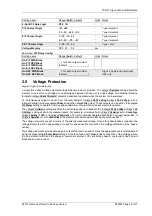
7SG11 Argus Technical Reference
©2013 Siemens Protection Devices Limited
P20007 Page 34 of 71
Table 2-16
Cold Load Pickup Settings
Sub-menu:
System Config.
Setting name
Range (
bold
= default)
Units Notes
Cold Load Pickup Group
1,2…
8
Sub-menu:
Auto-reclose
Setting name
Range (
bold
= default)
Units Notes
Cold Load Enable
OFF
, 0.20…2.0, 2.1…20, 21…
300, 360…3600, 3900…14400
sec
Cold Load Reset
0.20…2.0, 2.1…20, 21…300,
360…
600
…3600, 3900…14400
sec
2.7 Directional Control
Argus 2 and Argus 6 only
Each phase-fault and earth-fault delay characteristic, lowset and highset elements can be independently
programmed to non-directional, forward directional, reverse directional or bi-directional (tri-state) operation. The
SEF/REF element on most Argus 2 and Argus 6 models is not normally directional, however, a single-pole
directional SEF model is available.
Figure 1.5-7 illustrates the directional operating characteristic relative to the characteristic angle (CA), historically
known as the maximum torque angle. This is the phase angle of the fault current relative to the polarising voltage
reference for which the directional detector gives maximum sensitivity in the forward operate zone. The reverse
operate zone is an exact mirror image of the forward zone. The directional element is referred to as ‘tri-state’
because conditions will occur for which neither the forward nor the reverse element should operate.
If a protection element is programmed by the user to be non-directional then only non-directional overcurrent
settings will be presented. The element will operate independently of the output of the directional detector and
operation will occur for current above setting regardless of phase angle.
If a protection element is programmed for forward directional mode then the forward zone overcurrent settings will
be presented and operation will only occur for fault current falling within the forward operate zone. Conversely, if a
protection element is programmed for reverse directional mode then the reverse zone overcurrent settings will be
presented and operation will only occur for fault current falling within the reverse operate zone.
Where the tri-state option is selected an element will operate for fault current above its setting in either direction.
Different overcurrent settings can be programmed for forward and reverse operation. In addition, the forward and
reverse trip output signals can be issued to different output contacts.
Directional relays can be applied to directional blocking schemes. Both phase and/or earth fault blocking outputs
can be generated for forward or for reverse direction faults, e.g.
Protection:
P/F FWD Block
specifies relays which will
operate for a phase-fault in the forward direction.
Blocking inputs can be received via the status inputs, each of which can be programmed to inhibit operation of
any overcurrent protection element - see section 2.2.
2.7.1 Polarisation
Phase-fault
Voltage polarisation is achieved for the phase-fault elements using the quadrature voltage whereby each phase
current is compared to the voltage between the other two phases, i.e.
I
A
~ V
BC
I
B
~ V
CA
I
C
~ V
AB
Two types of directional element exist, referred to here as type I and type II. On a relay with type I directional
elements the phase-fault characteristic angles can be user programmed to 30 or +45 using the
Protection:
P/F Charact Angle
setting. On a relay with type II elements, any characteristic angle between -90 and +90
can be selected. The characteristic angle setting should be matched to the approximate expected nominal angle
of system fault, i.e. the source impedance angle.
Earth-fault
Voltage polarisation is also used for earth fault elements, comparing the earth fault current Ie (3I
0
) against the
system residual voltage Vn (3V
0
).
















































